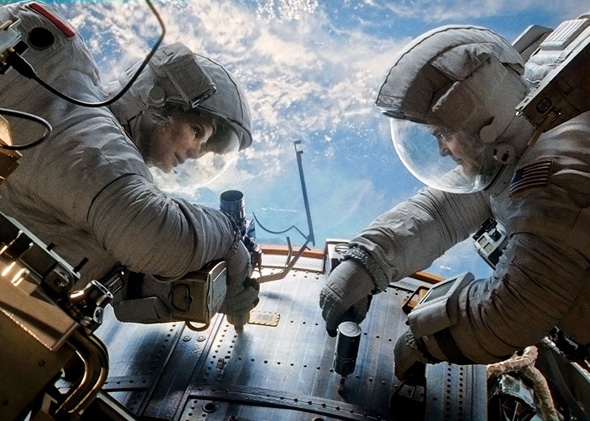Gravity
It gives outer space back its beauty, terror, and wonder.

Courtesy of Warner Bros. Pictures
After you’ve seen Gravity, come back and listen to our Spoiler Special:
Alfonso Cuarón’s innovative science-fiction thriller Gravity gets one thing so whompingly right it makes it easy to forgive the few things it gets wrong (most of which won’t fully register in your consciousness until you’re well out of the theater, so overwhelming is this movie’s visual and aural spectacle). Gravity’s great gift to the viewer is that it gives outer space back its beauty, terror, and wonder. In the past few decades—the age of the blockbuster—the awe-inspiring black chasm in which our tiny blue world floats has become little more than a dull, featureless causeway for the planet-to-planet transit of giant alien reptiles and Norse gods bearing hammers. The idea that space itself is fascinating, frightening, and worthy of our full cinematic attention—well, you might have to go as far back as Kubrick’s 2001: A Space Odyssey to find a movie that makes that case as well as Gravity.
This is not to say that Gravity is a masterpiece: Unlike Cuarón’s extraordinary Children of Men, it doesn’t quite pull off its ambitious effort to combine formal inventiveness, heart-pounding action, and intimate human storytelling. But it succeeds thrillingly at the first two of those categories, and only misses the mark on the last because it tries a little too hard—which is certainly a welcome respite from the countless sci-fi thrillers that privilege the human story not at all.
At any rate, you have to see Gravity. Not just in the sense that it’s a good movie you ought to go to, but in the sense that what sets it apart from your run-of-the-mill space opera has to be experienced via the eyes. The opening scene takes Cuarón’s signature shot—a virtuosic long take in which the action is carefully choreographed so that the camera is always where it needs to be—to the next level. Using extensive CGI (in many scenes, the actors’ faces behind their visors are the only unanimated elements), Cuarón and his longtime cinematographer, the wizardly Emmanuel Lubezki, have created a screen space that’s not only 3-D but convincingly polarity-free, with no solid sense of what’s up or down, background or foreground. The camera in this first shot doesn’t seem to be whirling through space as much as the universe seems to be revolving around us, with whatever object we need to see—an orbiting spacecraft, a character’s face in close-up, a dropped tool spinning into the void—floating into view just when we need to see it.
By the end of that nearly 20-minute-long shot, we’ve ascertained that the spacecraft in question is a shuttle docked near the Hubble telescope, where engineer Ryan Stone (Sandra Bullock) has been sent on her first-ever space mission. Her co-worker, the laid-back veteran astronaut Matt Kowalski (George Clooney)—who’s buzzing around her in circles in a jetpack as she replaces a part on the telescope’s exterior—enjoys giving her a hard time about her constant nausea and discomfort. We’ve also learned, via mission control (voice of the ur-screen astronaut Ed Harris) that the destruction of a Russian satellite has created a dangerous cloud of jagged debris that’s due to whiz past at any second.
As the two spacewalking astronauts scramble for safety, Ryan’s tether is severed, and she spins out alone into space—imagine that impossibly lonely shot in 2001 in which an untethered astronaut drifts out into the void, but from the astronaut’s point of view. How do you go about surviving by your wits when you’re nothing but an object with mass in space, subject to the cruel and inexorable rules of the law of physics referenced in the title?
I won’t tell you a thing about how Bullock’s character goes about solving that problem, because Gravity starts in early with the rug-pulling twists and keeps them coming straight up to the end. But I think it’s safe to disclose that this is an unusually paced action movie: Despite its trim 93-minute running time, there’s room for both contemplative beauty and chilling suspense (a structure enabled in part by that whirling space debris, which orbits the Earth at a set speed, allowing big action scenes to alternate with periods of eerie inactivity and silence).
I wish a little more of that silence had found its way into the screenplay (by Cuarón and his son Jónas, a young filmmaker working with his father for the first time). Clooney and Bullock’s exchanges in the early scenes have a disarming screwball charm—he’s an unflappable if fatalistic optimist, she’s an uptight loner with a tendency to give up too soon—but as their situation grows more grave and the movie’s tone more serious, the dialogue hits its thematic points—Loneliness! Courage! The Need to Connect!— a trifle too hard. Bullock’s character is given a back story that verges on the emotionally manipulative, and some late scenes where that story is referenced felt cooked up for the purpose of lending profundity to her struggle to survive this ordeal and get back to Earth. But Gravity was never in need of a profundity loan. The film’s recurring image of our distant, revolving planet, the light of its familiar human settlements visible from space, already told us everything about what it would mean to a stranded astronaut to find her way home.
